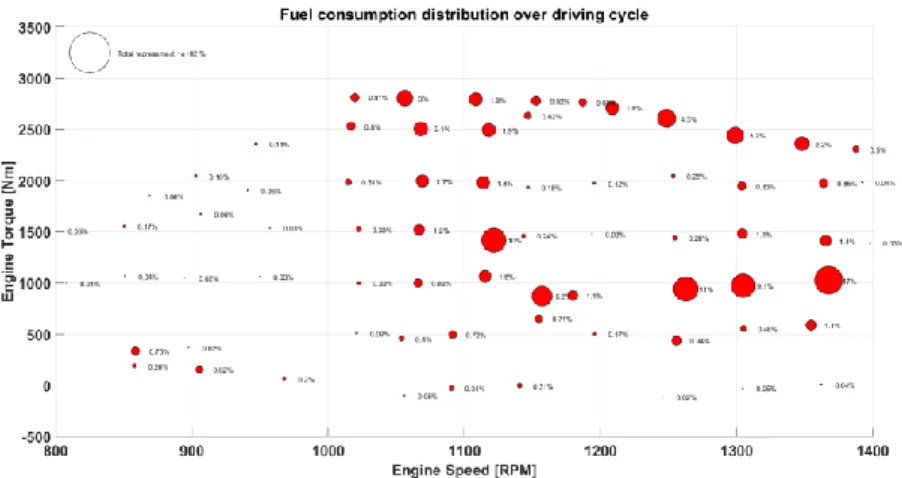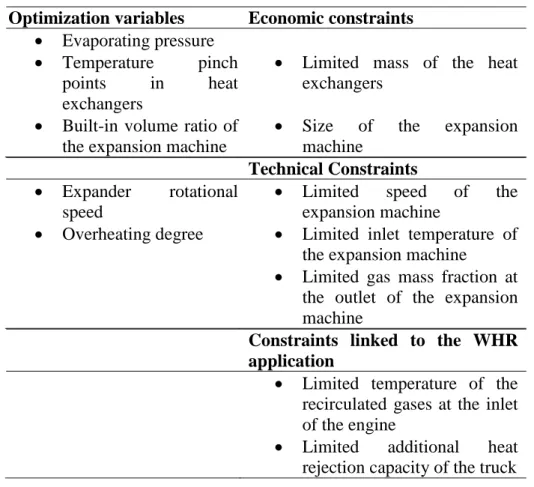BOOK OF ABSTRACTS OF THE 3RD ANNUAL ENGINE ORC CONSORTIUM WORKSHOP FOR THE AUTOMOTIVE AND STATIONNARY ENGINE INDUSTRIES
SEPTEMBER 14-16, 2016, BELFAST, U.K. THERMO-ECONOMIC OPTIMIZATION OF ORGANIC RANKINE CYCLE
SYSTEMS FOR WASTE HEAT RECOVERY FROM EXHAUST AND RECIRCULATED GASES OF HEAVY DUTY TRUCKS
L. Guillaumea, A. Legrosa, V. Lemorta
a Department of A&M, Thermodynamics laboratory, University of Liege, Belgium
e-mail: ludovic.guillaume@ulg.ac.be Web page : www.labothap.ulg.ac.be
Highlights: A methodology for the preliminary design phase of ORC systems recovering the
heat wasted from heavy duty trucks is proposed. Sizing models of ORC systems are described. They are capable of predicting the cycle performance with different working fluids and different components sizes. A three-steps optimization to identify the most promising system is achieved.
Key words: Organic Rankine Cycle, Waste Heat Recovery, Heavy Duty Trucks,
Thermo-Economic, Optimization.
EXTENDED ABSTRACT Introduction
Waste heat recovery (WHR) ORC is a very promising technology for reducing fuel consumption and consequently the CO2 emissions of future heavy-duty trucks (HDT). Nonetheless, the adoption of this technology in the automotive domain requires specific R&D activities going from the system definition to the on-board integration.
This study focuses on the preliminary design phase of ORC systems recovering the heat wasted from two of the sources available on a HDT: the exhaust and recirculated gases. From these heat sources and their combinations, 6 possible architectures are identified. On the other hand, 4 volumetric expansion machine technologies are considered (Scroll, Screw, Piston and Vane Expanders). At the end, 24 topologies are modelled considering only the main components (Pump, Heat exchangers, Expansion machines).
A three-step optimization method is proposed to identify the most promising system. First, the most suitable design conditions are identified using a simple model of expansion machine. In a second step, the design phase, using more detailed models for the expansion machines, a thermodynamic and economic optimizations are performed. Finally, in a third step, the output power of the latter system models is maximized in off-design conditions.
Description of the component models
1. The pump is modelled by its isentropic and volumetric efficiencies.
2. The heat exchangers are modelled by means of the Logarithmic Mean Temperature Difference (LMTD) method for counter-flow heat exchangers. They are subdivided into 3 moving boundaries zones, each of them being characterized by a heat transfer area A and convective heat transfer coefficients on both fluid sides. Various correlations are used for the calculation of the heat transfer coefficients and pressure drops on the working fluid side according to the phase of the fluid while a Dittus-Boelter type Nusselt correlation, whose parameters where identified based on
BOOK OF ABSTRACTS OF THE 3RD ANNUAL ENGINE ORC CONSORTIUM WORKSHOP FOR THE AUTOMOTIVE AND STATIONNARY ENGINE INDUSTRIES
SEPTEMBER 14-16, 2016, BELFAST, U.K.
experimental data, is used for the secondary fluid side.
3. Semi-empirical models are developed for each expander technology. These models take into account the main loss phenomena occurring during the expansion of the fluid and involve a limited number of physically meaningful parameters that can be easily identified from performance measurements. These parameters are identified based on reference expansion machines tested in laboratory.
Definition of the operating conditions
Based on data for engine torque, engine speed and fuel consumption along a customized driving cycle travelled by the truck, the fuel consumption distribution is mapped. For each fraction of consumption, using a single simplified model for the expansion machine, each of the 6 reduced topologies is designed optimizing the evaporating pressure so to maximize the output power. The performance of each system is then maximized in off-design for the other fractions of fuel consumption and a weighted average, according to the fraction of fuel consumption, of the power output is performed. The design conditions are selected comparing this mean value obtained for each architecture, working fluid and design fuel consumption percentage. Results indicate that the couple (engine torque, engine speed) corresponding to the maximal fraction of fuel consumption is generally identified as the most promising design point.
Figure 1: Fuel consumption distribution obtained for a heady duty truck travelling along the proposed driving cycle
Thermodynamic and economic optimizations in design conditions
Cost relations have been established for each component as a function of their size (heat transfer area for heat exchangers, displacement for the pump and the expansion machine) and assumptions on the other direct (piping, instrumentation, etc.) and indirect (engineering, etc.) costs of the systems have been performed. Thermodynamic and economic optimizations are performed in order to design the investigated systems and results are compared. The maximization of the output power on one side and the minimization of the specific investment cost (SIC) of the system on the other side are performed optimizing key variables of the components under constraints. Both variables and constraints are listed in Table 1.
BOOK OF ABSTRACTS OF THE 3RD ANNUAL ENGINE ORC CONSORTIUM WORKSHOP FOR THE AUTOMOTIVE AND STATIONNARY ENGINE INDUSTRIES
SEPTEMBER 14-16, 2016, BELFAST, U.K. Table 1: Optimization variables and constraints of the thermo-economic optimization
Optimization of the performance in off-design conditions
Finally, in a third step, the output power of the systems is maximized in off-design conditions optimizing the evaporating pressure and the overheating degree. As for the selection of the design conditions, a weighted average, according to the fraction of fuel consumption, is performed on the output power over all the investigated operating conditions (design and off-design) in order to identify the most promising topology for the waste heat recovery application in terms of performance.
References
[1] S. Quoilin, S. Declaye, B. Tchanche, V. Lemort, “Thermo-economic optimization of waste heat recovery Organic Rankine Cycles”, Applied Thermal Engineering 2011, 31, 14-15,2885-2893.
[2] L. Pierobon, T. Nguyen, U. Larsen, F. Haglind, B. Elmegaard, “Multi-objective optimization of organic Rankine cycles for waste heat recovery: Application in an offshore platform”, Energy 2013, 58, 538-549.
Background of the research and development team
This research was partly funded by European Commission in the frame of the NoWaste project.
Optimization variables Economic constraints
Evaporating pressure Temperature pinch
points in heat
exchangers
Limited mass of the heat exchangers
Built-in volume ratio of the expansion machine
Size of the expansion machine
Technical Constraints
Expander rotational speed
Limited speed of the expansion machine
Overheating degree Limited inlet temperature of the expansion machine
Limited gas mass fraction at the outlet of the expansion machine
Constraints linked to the WHR application
Limited temperature of the recirculated gases at the inlet of the engine
Limited additional heat rejection capacity of the truck
BOOK OF ABSTRACTS OF THE 3RD ANNUAL ENGINE ORC CONSORTIUM WORKSHOP FOR THE AUTOMOTIVE AND STATIONNARY ENGINE INDUSTRIES
SEPTEMBER 14-16, 2016, BELFAST, U.K. Authors
Ludovic Guillaume obtained his MSc (electromechanical engineering) at University of Liege where he is working now as a PhD student within the Energy Systems Research Group (Thermodynamics Laboratory). He has been working on waste heat recovery from engines since 2011, in collaboration with Industry and in the frame of public funded projects (FP7 Nowaste project).
Arnaud Legros obtained his MSc (mechanical engineering) and its PhD at University of Liege where he is working as a Postdoctoral research engineer within the Energy Systems Research Group (Thermodynamics Laboratory). He has been working on waste heat recovery from engines since 2010, in collaboration with Industry.
Vincent Lemort is an Assistant Professor at the University of Liège (Belgium), where he is leading the Energy Systems Research Group (Thermodynamics Laboratory). He has been working on waste heat recovery from engines since 2005, in collaboration with Industry and in the frame of public funded projects (FP7 Nowaste project). His team has contributed to the simulation and the testing of many ORC systems and components.

